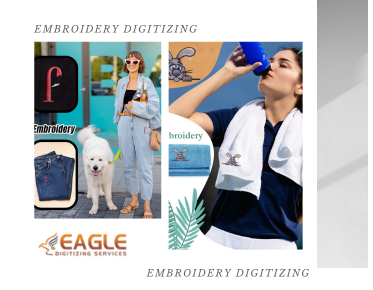The Importance of Source and Machine Formats in Embroidery Design
In the field of embroidery design, it is crucial to differentiate between source formats and machine formats. The source format, typically in EPS or AI vector formats, is invaluable for its editability. This format ensures that every element of the design is accessible for modification, allowing designers to make precise changes and adaptations. For future modifications, having a vector file is essential as it allows for adjustments in aspects such as dimensions, colors, and shapes. This flexibility is particularly important in the dynamic world of fashion, where trends and customer preferences can shift rapidly. Designers are encouraged to maintain this vector format as the primary reference before submitting the design to an embroidery digitizer.
The Evolving Fashion Landscape and Designer Adaptability
Fashion is a reflection of the times, and in today's fast-paced world, it is constantly evolving. This rapid change is driven by a young generation eager for new and innovative styles. As a result, designers must remain adaptable, continuously updating their concepts and techniques. Our design team, consisting of professionals with advanced backgrounds and a keen sense of current fashion trends, is well-equipped to meet these demands. They are not only skilled in traditional design techniques but also adept at incorporating modern trends and cultural influences into their work. This approach ensures that our designs are always fresh, unique, and aligned with the latest fashion movements.
Advanced Techniques and Tools in Embroidery Digitizing
Embroidery digitizing is an intricate process that transforms a design from a concept into a physical reality. This process requires a blend of artistic creativity and technical precision. At Eagle Digitizing, we excel in creating both 2D and 3D embroidery designs, using advanced software and machinery. The digitization process involves converting a vector design into a format that can be interpreted by embroidery machines. This conversion is not merely a technical translation; it involves considering factors such as stitch density, thread tension, and color blending to achieve the desired visual effects. Machine formats like EMB, PES, ART, VIP, JEF, and SEW are tailored for specific embroidery machines and purposes, ensuring compatibility and quality in the final product.
Efficient Embroidery Production and Material Preparation
The production phase of embroidery involves careful preparation and execution. The first step is the preparation of materials, which includes selecting the appropriate types of thread and backing materials based on the design's requirements. For example, threads can be made from materials like wool, nylon, or polyester, each offering different textures and strengths. The choice of thread impacts the durability and appearance of the embroidery, especially in multi-color designs where thread changes are frequent. The embroidery process itself is highly automated, with machines capable of performing complex stitching patterns. However, this automation requires precise programming and setup, including the arrangement of hoops and the calibration of thread tensions. Simple designs can be completed quickly, but more complex, multi-color designs may take longer due to the need for precise thread changes and adjustments.
Eagle Digitizing's Commitment to Quality and Timeliness
At Eagle Digitizing, we are committed to delivering high-quality embroidery services efficiently. Our facility is equipped with specialized machinery for various tasks, including embroidery, sewing, and finishing. This division of labor allows us to handle large orders with speed and accuracy, ensuring that our clients receive their products on time. We also offer a range of complementary services, such as design consultation and sample production, to help clients refine their ideas before full-scale production. Our extensive portfolio of past projects is available for review, providing prospective clients with a clear understanding of our capabilities and style. Additionally, we offer a selection of free embroidery designs, showcasing the diversity and creativity of our work.
Understanding the Technical Aspects of Embroidery Machines
Embroidery machines vary significantly in their capabilities and specifications. Understanding these differences is crucial for both designers and clients. For example, some machines are better suited for high-density stitching, while others excel in creating delicate, detailed patterns. The choice of machine can affect not only the quality of the embroidery but also the speed and cost of production. At Eagle Digitizing, we use state-of-the-art machines that are regularly maintained and updated to ensure optimal performance. This commitment to using the best equipment available reflects our dedication to quality and customer satisfaction.
The Role of Software in Embroidery Digitizing
The software used in embroidery digitizing plays a critical role in the process. Advanced embroidery software allows digitizers to control every aspect of the design, from stitch type and direction to color transitions and layering. This level of control is essential for achieving the desired artistic effect and ensuring that the final product meets the client's specifications. Moreover, software advancements have enabled more complex and detailed designs to be produced, expanding the possibilities for creativity in embroidery. Our team at Eagle Digitizing is proficient in using the latest software tools, which enables us to offer a wide range of styles and techniques to our clients.
The Importance of Material Selection in Embroidery
Material selection is a fundamental aspect of the embroidery process that can significantly influence the final product. Different materials react differently to stitching, and choosing the right one can affect the durability and appearance of the embroidery. For instance, synthetic threads like polyester are known for their strength and resistance to fading, making them ideal for items that will undergo frequent washing. On the other hand, natural threads like cotton or silk offer a unique texture and sheen that can enhance the aesthetic appeal of the design. At Eagle Digitizing, we guide our clients through the material selection process, ensuring that they choose the best options for their specific needs.
The Impact of Embroidery on Brand Identity
Embroidery is more than just a decorative technique; it is also a powerful tool for branding. Custom embroidery can enhance the perceived value of a product, adding a touch of professionalism and exclusivity. Whether used on corporate uniforms, promotional items, or fashion apparel, embroidery helps to reinforce brand identity and create a cohesive brand image. At Eagle Digitizing, we understand the importance of branding and work closely with our clients to ensure that their embroidered products align with their brand values and aesthetic.
Trends in Embroidery Design
Like all areas of fashion and design, embroidery is subject to trends. These trends can include color palettes, stitch patterns, and even the types of products being embroidered. Staying current with these trends is important for both designers and digitizers, as it ensures that their work remains relevant and appealing to contemporary audiences. At Eagle Digitizing, we stay abreast of the latest trends in the industry, incorporating new techniques and styles into our offerings. This commitment to innovation helps us to provide our clients with fresh and fashionable designs that stand out in the market.
Customization and Personalization in Embroidery
One of the key benefits of embroidery is its capacity for customization and personalization. This is particularly valuable in markets such as corporate apparel, sportswear, and promotional products, where unique branding is crucial. Through the use of embroidery, clients can personalize items with logos, names, or bespoke designs, creating a unique and personal connection with the end user. At Eagle Digitizing, we offer a wide range of customization options, allowing our clients to create truly unique products that reflect their brand or personal style.
The Environmental Impact of Embroidery
In recent years, there has been growing awareness of the environmental impact of textile production, including embroidery. Factors such as material waste, energy consumption, and chemical use are all considerations in the sustainability of embroidery practices. At Eagle Digitizing, we are committed to minimizing our environmental footprint. We use eco-friendly materials where possible and implement efficient production processes to reduce waste. Additionally, we educate our clients on the most sustainable choices for their embroidery projects, helping them to make informed decisions that align with their environmental values.
Future Directions in Embroidery Technology
The future of embroidery technology promises exciting advancements, particularly in areas such as automation and digital integration. Innovations such as computerized embroidery machines with artificial intelligence capabilities could revolutionize the industry, making the process more efficient and allowing for even greater design complexity. At Eagle Digitizing, we are excited about these developments and are committed to staying at the forefront of technological advancements. We continuously invest in new equipment and training for our staff to ensure that we can offer the latest and most advanced services to our clients.
Conclusion: Choosing the Right Embroidery Partner
Choosing the right partner for embroidery digitizing and production is crucial to achieving the desired results. At Eagle Digitizing, we pride ourselves on our expertise, advanced technology, and commitment to quality. Our comprehensive services, from design to final production, ensure that our clients receive a product that meets their expectations and enhances their brand. Whether you are looking for simple monogramming or complex multi-color designs, we have the skills and resources to bring your vision to life. Contact us today to learn more about our services and how we can help you achieve your embroidery goals.
FAQs
1. What is the difference between vector and machine embroidery formats?
Vector formats like EPS and AI allow for full editability of designs, while machine formats such as EMB and PES are used for actual embroidery production.
2. Why is material selection important in embroidery?
Material selection affects the durability, texture, and appearance of the embroidery, making it crucial for achieving the desired quality and aesthetic.
3. How does embroidery enhance brand identity?
Custom embroidery adds a professional and exclusive touch to products, reinforcing brand identity and creating a cohesive brand image.
4. What trends are currently popular in embroidery design?
Trends include the use of bold color palettes, intricate stitch patterns, and eco-friendly materials, reflecting broader movements in fashion and sustainability.
5. How is Eagle Digitizing addressing environmental concerns in embroidery?
Eagle Digitizing uses eco-friendly materials and efficient production processes to minimize waste and reduce the environmental impact of their embroidery services.



